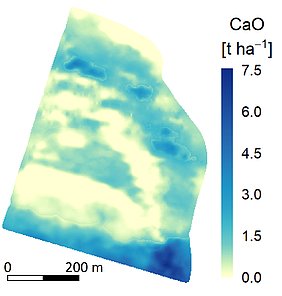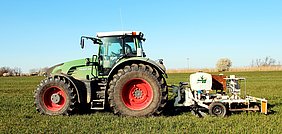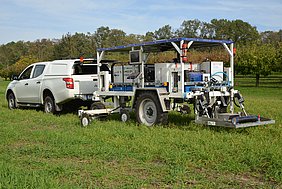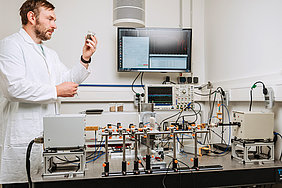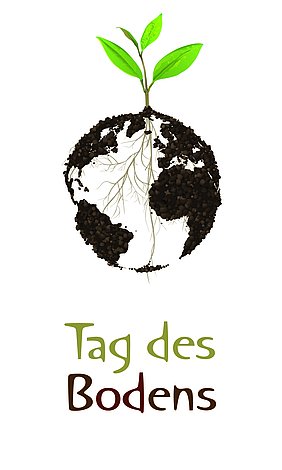Soil is a sensitive and as a result of intensive agriculture often strained resource. Scientists at the Leibniz Institute of Agricultural Engineering and Bioeconomy are therefore developing digital solutions for a resource-saving and environmentally sound soil management. With the World Soil Day on 5 December, the Food and Agriculture Organisation (FAO) and the United Nations (UN) are reminding us to stand up for a sustainable management of soil resources.
Sometimes a glance from the edge of the field onto the acre is all it takes to detect the differences with the naked eye: There are areas where the soil provides better growing conditions for plants than in others. These differences should be taken into account when it comes to fertilisation and other soil management measures, for example, to avoid nutrient deficiencies in some areas, tantamount to yield losses. In other areas, it is important to avoid excessive nurtient supply, which would cause environmental pollution and waste resources. However, fertilisation and tillage are still mainly applied in a uniform manner. A detailed recording of the spatial variability in the soil is a prerequisite for a site-specific soil management, thus, optimizing yield and conserving resources.
Scientists at the Leibniz Institute of Agricultural Engineering and Bioeconomy are therefore developing sensor-based technologies to enable a detailed "look into the soil" - differentiated for almost every square metre.
The I4S "Intelligence for Soil" project targets the development of a system of soil sensors, models and decision algorithms that will facilitate the demand-oriented management of fertilisation and thus enable the maintenance or improvement of soil fertility. The researchers are focusing on the development of a mobile sensor platform that will collect data on nutrient content, pH value, organic matter, texture, etc. while driving over the field. A wide range of sensors, including ion-selective electrodes, geoelectrics, laser-induced plasma spectroscopy, Raman, gamma, x-ray fluorescence as well as visible and infrared spectroscopy (VisNIR, MIR) on the platform will provide high-resolution sensor data from which soil maps can be generated. The information on physical and chemical soil properties is either directly used to calculate maps of nutrient requirements or is integrated into dynamic soil-process models in order to predict water and nutrient turnover and to forecast plant growth or yield on a site-specific basis. The result of the research will be a decision support system that provides farmers with tailor-made site-specific recommendations for fertilisation with a.o. nitrogen, phosphorus, potassium and lime.
The simultaneous measurement of several yield-relevant soil properties with only one passage requires the combination of different sensor systems. In order to adapt the sensor technologies for combined field use on the multi-sensor platform, a close interaction of basic research and application-oriented testing is required. "Some systems have been tested at laboratory level, others are already proven for mobile use in the field. Currently, we are working with terahertz spectroscopy which is tested for the first time on the medium soil," explains Dr. Sebastion Vogel, head of the I4S project. "The fusion of sensor data and their processing with machine learning methods will significantly improve the prediction of various soil properties".
One step closer to practical application is the project "pH-BB: Precision Liming in Brandenburg". This project aims at a feasible management of the soil acidity of agricultural farms in the State of Brandenburg. The pH value affects several yield-relevant soil properties, such as nutrient availability, pollutant mobility or soil structure. In Brandenburg, only about 30 percent of the arable land is optimally supplied with lime. In contrast, on around 70 percent of the land too high or too low pH values result in yield reductions. In order to facilitate a rapid access to precision liming using mobile soil sensors, researchers, agricultural service providers and practitioners are working closely together in the pH-BB project. The three soil properties relevant for liming - texture, soil organic matter content and pH - are measured by using a sensor platform (Veris Technologies). Our studies show that only a few chemically analysed reference samples are required to calibrate the many hundreds of sensor measurements and to create precise soil maps. "The mapping provides a data set of high resolution with tiles of about two square metres. These fine differences have to be taken into account in lime fertilisation, not least in order to compensate for the over- or undersupply as a result of the past fertilisation practice ", explains Dr. Sebastian Vogel. "All we need now is a suitable lime spreader that will be able to implement these small-scale differences in the future".
Technologies for site-specific fertilisation and tillage are not yet widely used in agricultural practice. They are considered too complex and expensive. "However, the necessity of more precise soil mapping and site-specific fertilisation is undeniable in view of ever stricter statutory fertilisation ordinance", ATB expert Vogel is convinced. "The additional expense of comprehensive soil mapping with sensors, carried out by a service provider for example, will pay off for farmers. In the long term, improved nutrient supply, biology and higher water storage capacity of soils and thus more stable and higher yields can be expected".
The project "pH-BB: Precise Liming in Brandenburg" is funded under the European Innovation Partnership "Agricultural Productivity and Sustainability" (EIP-AGRI). The funds are provided by the Investment Bank of the State of Brandenburg (ILB). http://ph-bb.com/
"Integrated System for Site-Specific Management of Soil Fertility (Intelligence for Soil - I4S)" is one of ten interdisciplinary consortia under the auspices of the BMBF's long-term funding measure "BonaRes - Soil as a Sustainable Resource for the Bioeconomy" (www.bonares.de), launched in 2015. The project, uniting ten research institutions, is coordinated by the Leibniz Institute of Agricultural Engineering and Bioeconomy (ATB). http://i4s.atb-potsdam.de
Publications in the context:
Dworak, V.; Mahns, B.; Gebbers, R.; Weltzien, C.: Hyperspectral imaging Tera Hertz system for soil analysis: Initial results. Sensors 20 (19): 5660, 2020. https://doi.org/10.3390/s20195660
Bönecke, E.; Meyer, S.; Vogel, S.; Schröter, I.; Gebbers, R.; Kling, C.; Kramer, E.; Lück, K.; Nagel, A.; Philipp, G.; Gerlach, F.; Palme, S.; Scheibe, D.; Zieger, K.; Rühlmann, J.: Guidelines for precise lime management based on high-resolution soil pH, texture and SOM maps generated from proximal soil sensing data. Precision Agriculture: 1-31, 2020. https://doi.org/10.1007/s11119-020-09766-8
Vogel, S.; Bönecke, E.; Kling, C.; Kramer, E.; Lück, K.; Philipp, G.; Rühlmann, J.; Gebbers, R.: Base neutralizing capacity of agricultural soils in a quaternary landscape of North-East Germany and its relationship to best management practices in lime requirement Determination. Agronomy 10 (877): 1-19, 2020. https://www.mdpi.com/2073-4395/10/6/877
Find more information on YouTube: https://youtu.be/prRryb-frCY
Contact:
Dr. Sebastian Vogel – Project coordination I4S
Tel.: +49 (0)331 5699-426, Email: svogel@atb-potsdam.de
Helene Foltan – Public relations
Tel.: +49 (0)331 5699-820, Email: presse@atb-potsdam.de
Leibniz Institute for Agricultural Engineering and Bioeconomy (ATB)
Max-Eyth-Allee 100, 14469 Potsdam, Germany
The research of the Leibniz Institute of Agricultural Engineering and Bioeconomy (ATB) at the interface of biological and technical systems aims to create the basis for sustainable bioeconomic production systems. For this purpose, ATB develops and integrates new technologies and management strategies for a knowledge-based, site-specific production of biomass and its use for nutrition, as biobased products and as energy sources - from basic research to application. www.atb-potsdam.de

